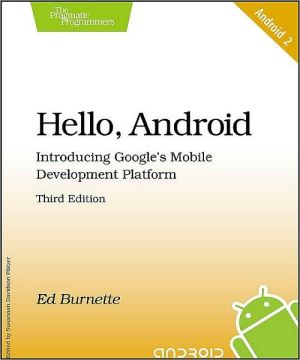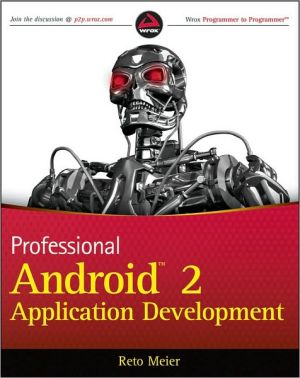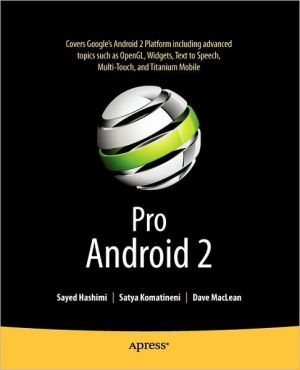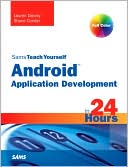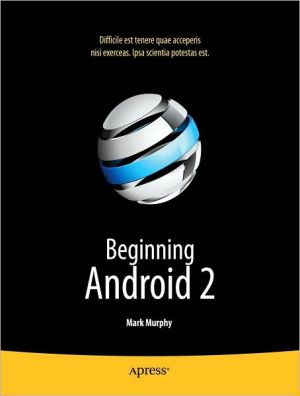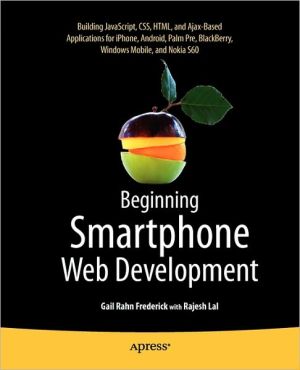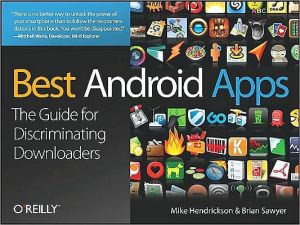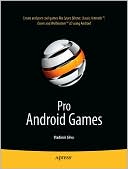Hello, Android: Introducing Google's Mobile Development Platform
Google's Android is shaking up the mobile market in a big way. With Android, you can write programs that run on any compatible cell phone or tablet in the world. It's a mobile platform you can't afford not to learn, and this book gets you started. Hello, Android has been updated to Android 2.3.3, with revised code throughout to reflect this updated version. That means that the book is now up-to-date for tablets such as the Kindle Fire. All examples were tested for forwards and backwards...
Search in google:
Android is a new software toolkit for mobile phones, created by Google and the Open Handset Alliance. In a few years, it's expected to be found inside millions of cell phones and other mobile devices, making Android a major platform for application developers. That could be your own program running on all those devices. Getting started developing with Android is easy. You don't even need access to an Android phone, just a computer where you can install the Android SDK and the phone emulator that comes with it. Within minutes, "Hello, Android" will get you creating your first working application: Android's version of "Hello, World." From there, you'll build up a more substantial example: an Android Sudoku game. By gradually adding features to the game throughout the course of the book, you'll learn about many aspects of Android programming including user interfaces, multimedia, and the Android life cycle. If you're a busy developer who'd rather be coding than reading about coding, this book is for you. To help you find what you need to know fast, each chapter ends with "Fast forward" section. These sections provide guidance for where you should go next when you need to read the book out of order.
Acknowledgments xiPreface xiiiWhat Makes Android Special? xiiiWho Should Read This Book? xivWhat's in This Book? xvWhat's New for Cupcake? xvWhat's New for Donut? xviOnline Resources xviFast-Forward xviiI Introducing Android 11 Quick Start 31.1 Installing the Tools 31.2 Creating Your First Program 71.3 Running on the Emulator 71.4 Running on a Real Phone 101.5 Fast-Forward» 112 Key Concepts 152.1 The Big Picture 152.2 It's Alive! 202.3 Building Blocks 242.4 Using Resources 252.5 Safe and Secure 262.6 Fast-Forward» 27II Android Basics 293 Designing the User Interface 313.1 Introducing the Sudoku Example 313.2 Designing by Declaration 323.3 Creating the Opening Screen 333.4 Using Alternate Resources 413.5 Implementing an About Box 443.6 Applying a Theme 493.7 Adding a Menu 503.8 Adding Settings 533.9 Starting a New Game 553.10 Debugging with Log Messages 573.11 Debugging with the Debugger 583.12 Exiting the Game 583.13 Fast-Forward » 594 Exploring 2D Graphics 614.1 Learning the Basics 614.2 Adding Graphics to Sudoku 664.3 Handling Input 754.4 The Rest of the Story 814.5 Making More Improvements 904.6 Fast-Forward» 915 Multimedia 935.1 Playing Audio 935.2 Playing Video 995.3 Adding Sounds to Sudoku 1045.4 Fast-Forward » 1076 Storing Local Data 1096.1 Adding Options to Sudoku 1096.2 Continuing an Old Game 1116.3 Remembering the Current Position 1136.4 Accessing the Internal File System 1156.5 Accessing SD Cards 1166.6 Fast-Forward » 117III Beyond the Basics 1197 The Connected World1217.1 Browsing by Intent 1227.2 Web with a View 1267.3 From JavaScript to Java and Back 1317.4 Using Web Services 1387.5 Fast-Forward » 1498 Locating and Sensing 1518.1 Location, Location, Location 1518.2 Set Sensors to Maximum 1578.3 Bird's-Eye View 1608.4 Fast-Forward » 1669 Putting SQL to Work 1679.1 Introducing SQLite 1679.2 SQL 101 1689.3 Hello, Database 1709.4 Data Binding 1789.5 Using a Content Provider 1819.6 Implementing a Content Provider 1849.7 Fast-Forward » 18510 3D Graphics in OpenGL 18710.1 Understanding 3D Graphics 18710.2 Introducing OpenGL 18810.3 Building an OpenGL Program 18910.4 Rendering the Scene 19110.5 Building a Model 19510.6 Lights, Camera 19810.7 Action! 20110.8 Applying Texture 20110.9 Peekaboo 20510.10 Measuring Smoothness 20610.11 Fast-Forward » 207IV Appendixes 209A Java vs. the Android Language and APIs 211A.1 Language Subset 211A.2 Standard Library Subset 213A.3 Third-Party Libraries 214B Hello, Widget 215B.1 Creating Your First Widget 215B.2 Calling All Widgets! 217B.3 Stretch to Fit 218B.4 The Rest of the Story 219B.5 Running the Widget 220B.6 Keeping Up to Date 222B.7 Go Wild 224C Publishing to the Android Market 225C.1 Preparing 225C.2 Signing 228C.3 Publishing 229C.4 Updating 231C.5 Closing thoughts 233D Bibliography 233Index 235
